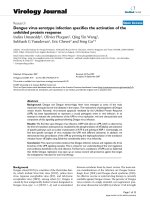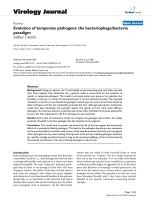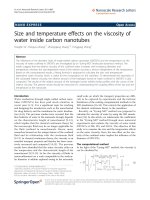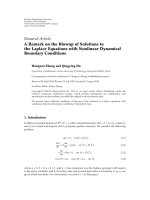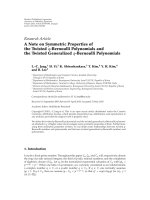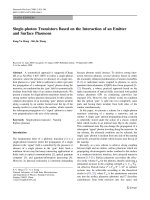Báo cáo sinh học: "Evolution underground: shedding light on the diversification of subterranean insects" pps
Bạn đang xem bản rút gọn của tài liệu. Xem và tải ngay bản đầy đủ của tài liệu tại đây (648.36 KB, 5 trang )
Cave organisms have long been considered a model
system for testing evolutionary and biogeographic hypo-
theses because of their isolation, simplicity of community
structure and specialization. Adaptation to cave environ-
ments promotes the regression of functionless (unused)
characters across a broad taxonomic range, in concert
with evolutionary change in other morphological traits.
Change typically involves the degeneration of eyes and
loss of pigments, while at the same time appendices
become elongated, intensification of sensory organs
occurs, and life cycles become modified -a syndrome
known as troglomorphy [1].
Modes of speciation and explanations for the geo-
graphic distributions of subterranean animals have both
been debated (see for example [2,3]). Extrinsic environ-
mental factors causing extinction of surface ancestors
pre-adapted to the subterranean (such as glaciations or
aridification) are suggested to be a mechanism forcing
populations underground. is model is usually invoked
in limestone cave systems of continental temperate
regions. However, among tropical faunas, in which
surface (epigean) taxa are often found co-occurring with
subterranean sister taxa, active colonization of the
subterranean habitat is suggested as a more plausible
explanation [2]. Mirroring this debate, both the
development of a topographic or ecological barrier
resulting in the separation of a once continuously
distributed ancestral population or species into separate
populations (vicariance) and dispersal, have been
discussed as contrasting factors shaping subterranean
animal distributions. Vicariance is typically considered
the dominant of these two processes, as subterranean
species have very limited dispersal potential, particularly
in ecologically unsuitable areas [4].
Testing hypotheses of origin and adaptation among
subterranean taxa has been hindered by the inherent
difficulties of sampling the rare and more elusive cave
taxa and extensive morphological convergence caused by
strong selection pressures imposed by the subterranean
environment [4]. In recent years molecular phylogenies
have been obtained for numerous taxonomic groups
contain ing subterranean lineages, permitting rigorous
comparisons of competing evolutionary hypotheses. In a
study published in BMC Evolutionary Biology, Ribera et
al. [5] have investigated the origin and evolution of a
diverse lineage of subterranean beetles of the tribe
Leptodirini (family Leiodidae) (Figure1a), focusing on the
distribution of this group in the western Mediter ranean.
is study is one of the first in which the evolutionary
history of a presumably monophyletic group composed of
mostly subterranean species is examined using molecular
data. Samples of a large number of species from genera
occurring in the Iberian Peninsula plus representatives
from Sardinia and the Carpathians are included in the
study. DNA sequences totalling 4 kilobases from five
mitochondrial and two nuclear DNA fragments were used
to construct robust phylogenies using different methods
and to quantify diversification patterns and times from
molecular clock calibrations.
Speciation in cave-dwelling organisms
e evolutionary passage from the surface to a terrestrial
or aquatic subterranean environment involves an array of
adaptations to a highly specialized habitat characterized
by permanent darkness and peculiar ecological features,
such as humidity in terrestrial caves, scarce and patchy
Abstract
A recent study in BMC Evolutionary Biology has
reconstructed the molecular phylogeny of a large
Mediterranean cave-dwelling beetle clade, revealing
an ancient origin and strong geographic structuring.
It seems likely that diversication of this clade in the
Oligocene was seeded by an ancestor already adapted
to subterranean life.
© 2010 BioMed Central Ltd
Evolution underground: shedding light on the
diversification of subterranean insects
Carlos Juan*
1
and Brent C Emerson
2
See research article />M I N IR EV IE W
*Correspondence:
1
Department de Biologia, Universitat de les Illes Balears, 07122 Palma de Mallorca,
Spain
Full list of author information is available at the end of the article
Juan and Emerson Journal of Biology 2010, 9:17
/>© 2010 BioMed Central Ltd
food resources, and constant temperature. Many evolu-
tionary studies of subterranean taxa have concentrated
on the origin of the lineages and the tempo and mode of
troglomorphic adaptations [3].
e geographic distributions and phylogenetic relation-
ships of surface taxa and related subterranean taxa can
help to distinguish between the two key hypotheses of
origin; the parapatric (termed in the specialized literature
the ‘adaptive shift hypothesis’) and allopatric (the ‘climatic
relict hypothesis’) models (Figure 2; [2,3,6] and references
therein). Parapatric describes the situation where two
species or distinct populations of the same species
overlap to a limited extent, while allopatric describes the
situation where species or populations have mutually
exclusive distributions.
e allopatric model predicts that surface species
either became extinct as a result of climatic change,
leaving only cave-adapted populations remaining, or
survive in geographic areas that were unaffected by
climatic change (and are thus allopatric with regard to
the subterranean populations). Within this model an
extrinsic cessation of gene flow caused by extirpation of
the surface populations explains the origin of cave-
dwelling organisms. In contrast, the adaptive shift hypo-
thesis advocates differentiation by divergent natural
selection and consequent reduction of gene flow between
surface and underground populations. e prediction
from this is that closely related epigean and subterranean
species will have parapatric distributions [2]. However,
reduced power to distinguish between these hypotheses,
or even incorrect inference, can be expected if extinction
of only some epigean populations or species has
occurred, or if there have been significant changes in
geographic distributions [3].
Figure 1. Cave-beetles and phylogenies. (a) Photograph of the cave-beetle species Cytodromus dapsoides (Leptoridini, Leiodidae) from the
Vercors National Park in Southeast France. The tribe Leptodirini includes about 235 genera and around 900 species, most of them exclusively
subterranean. The highest diversity is found in the north and east of the Iberian Peninsula, Corsica and Sardinia, the southern Alps, Balkan Peninsula,
Romania and southern Russia, the Caucasus, Middle East and Iran. (b) Simplied phylogenetic tree obtained by Ribera et al. [5] using combined
mitochondrial and nuclear sequences. The tree was linearized (tted to constancy of molecular substitution rate) using Bayesian methods. Red
circles indicate tree nodes used for calibration of the molecular clock using the mitochondrial gene cox1 only (considering 33 million years ago
for the age of initial separation of Sardinian species from their sister lineage), and including all mitochondrial sequence information but excluding
species from Sardinia (from which only cox1 sequences were available). In the latter case an estimated age of 37.8 million years ago was used for
the separation of Bathysciola zariquieyi from its sister. The width of each clade is proportional to the number of species included in the study. The
basal Speonomidius lineage includes the muscicolus genus Notidocharis. A geological timeline with the relevant epochs is provided below the tree.
Figure 1a courtesy of Christian Vanderbergh.
Cantabrian mountains
Speonomidius group
Central and eastern Pyrenees
Central and western Pyrenees
Cantabrian mountains
Central Mediterranean coast
Pyrenees
Sardinia
Northern Mediterranean coast
Bathysciola zariquieyi
Ovobathysciola group
Bathysciola ovata
Spelaeochlamys group
Quaestus group
Speonomus group
33
37.8
Eocene Oligocene Miocene
Pliocene
Pleistocene
34 23 5.3 2.644 million years
(a) (b)
Juan and Emerson Journal of Biology 2010, 9:17
/>Page 2 of 5
Inferring patterns of subterranean evolution from
molecular phylogenies
Reconstruction of evolutionary surface-to-subterranean
transitions in a range of arthropods (for example, terres-
trial and aquatic beetles, crickets, spiders, amphipods,
isopods, shrimps and crayfish) and vertebrates (for
example, fish and salamanders) deduced from molecular
phylogenies has lent support to both the parapatric and
allopatric models, with parapatric distributions being
more frequently recovered in tropical regions (for
example, in Hawaiian isopods and Canary Island beetles
and spiders) [7]. is could be due to the lack of climatic
events affecting surface populations, to geologic factors,
or because of recent adaptation to cave life in these areas.
In some of these cases geographically restricted lineages
include subterranean and surface species, showing
Figure 2. Speciation models in subterranean taxa. Schematic diagram of (a) the ‘climatic relict’ and (b) the ‘adaptive shift’ hypotheses. In the
former, a broadly distributed surface species that has exaptations (pre-adaptations) to the underground environment invades the caves. The
underground population remains in contact with the surface population, limiting genetic divergence of the two. Climatic oscillations cause local
extinction of surface populations, whereas surviving populations remain in the underground. The predictions from this for geographic distribution
are that either only relict cave-dwelling lineages survive, or surface populations are strictly allopatric and geographically remote with respect to
the underground. Over time, cave populations dierentiate, developing troglomorphic characters and become reciprocally monophyletic. In
the adaptive shift hypothesis caves are invaded by surface populations, exploiting new resources with the establishment of dierential selection
pressures in the epigean and underground environments. Speciation is driven by divergent selection accompanied by a reduction of gene ow. In
this case, surface and cave species are expected to have parapatric distributions, at least during the initial phases of the process. Ellipses represent
geographic distributions of populations. Troglobite is the term given to animals that have become adapted to dwell in cave environments and that
cannot survive outside such environments. Diagram modied from Figures 1 and 2 in [2].
Climatic relict hypothesis
Cave passive
colonization
Surface extinction
(relict cave species)
or
Local extinction
(allopatric surface
and cave species)
Pre-adapted
surface species
Parapatric
surface and cave
species
Restricted gene
flow
Cave active
colonization
Pre-adapted
surface species
Adaptive shift hypothesis
Surface
e
x
ta
n
t
Outgroup Surface ancestral
Cave troglobite
(a)
(b)
Juan and Emerson Journal of Biology 2010, 9:17
/>Page 3 of 5
evidence of multiple colonization of the subterranean
habitat [8].
e study of Ribera et al. [5] focuses on a monophyletic
beetle lineage that is composed primarily of subterranean
taxa, with only one lineage representing species with
eyes, living in moss habitats (genus Notidocharis).
Although the genus Notidocharis has been assumed to be
the sister-group of the remaining Leptoridini, Ribera et
al. find that it occupies an ambiguous position close to
the origin of the clade [5]. is basal placement of
Notidocharis and the fact that some subterranean
lineages have not been sampled limits definitive conclu-
sions about the relationship of subterranean species with
surface relatives. However, given the monophyly of
Notidocharis, the number of subterranean lineages, and
the geographic distribution of subterranean clades, the
pattern strongly suggests that extensive speciation has
occurred within the underground domain.
e major monophyletic subterranean Leptoridini
lineages are geographically structured in the mountain
massifs of the Iberian Peninsula and the deduced asso-
ciated divergence times reveal ancient divisions
(Figure1b). e conclusion, given the absence of surface
relatives, is that diversification took place within the
subterranean habitat from ancestors adapted to cave life
via dispersal and subsequent isolation due to geo-
graphical factors causing vicariance [5]. It is unclear
which of these latter two factors has prevailed, but this
conclusion does imply greater dispersal ability than has
been previously recognized for subterranean animals.
Molecular clocks and estimation of the age of
subterranean lineages
e correlation of divergence times of surface-to-
subterranean transitions with independent estimates of
paleoclimatic or geologic events can be used to explain
extinction of ancestors or the origin of new subterranean
habitats [3]. ‘Molecular clock’ approaches, based on the
quasi-constant rate of molecular evolution, have been
extensively used in evolutionary biology to estimate the
age of origin of taxa. However, the scarcity of fossil data
for many taxonomic groups requires the use of extrinsic
nucleotide substitution rates obtained from other
organisms and/or genes, or calibration of the clock from
biogeographic datings of vicariant species or populations.
e time of separation of the Sardinian microplate
from the continent has previously been used to estimate
rates of nucleotide change in the gene for mitochondrial
cytochrome oxidase subunit 1 (cox1) in subterranean
Leptodirini [1]. at study concluded that Sardinian and
Pyrenean species diversification occurred during the mid
to late Miocene (16 to 4.6 million years ago), contem-
poraneously with ecological and geologic changes in the
western Mediterranean region. In the more comprehensive
study of Ribera et al. [5], the authors date the origin of
the main Pyrenean Leptodirini clades to be approximately
34 million years ago, close to the formation of the
Pyrenees and the beginning of its cave formation (early
Oligocene), whereas the Cantabrian massif of the Iberian
Peninsula and coastal Mediter ranean clades appear to be
even older [5] (Figure 1b).
Challenges and future directions
Explaining subterranean insect origin can prove to be
more complicated than distinguishing between simple
allopatric or parapatric models, and may require careful
estimation of ongoing or historical gene flow between the
two habitats [6]. For instance, a repeated colonization of
lava tubes with local extinction of some of the surface
populations due to progressive drought has been suggest-
ed to explain the origin of subterranean amphipods in the
island of La Palma in the Canary archipelago [8]. It has
also been pointed out that important parameters such as
dispersal capacity, population size, and ability to adapt
and persist have been probably underestimated in
subterranean animals [9]. In addition, a considerable
number of previously unrecognized (morphologically
cryptic) species are increasingly being revealed by
molecular data, especially in animals that live in sub-
terranean groundwater (stygobionts), in some cases
contradicting what have appeared to be widespread
distributions [10,11]. e use of conserved molecular
markers should prove particularly exciting for future
studies of extreme disjunct biogeographic distributions
in stygobiont crustaceans [12], and the devising of
appropriate models to understand post-colonization
speciation within the caves on the basis of individual case
studies [7].
Acknowledgements
We are grateful to Christian Vanderbergh for providing the photograph in
Figure 1a. CJ’s research on subterranean crustaceans is supported by Spanish
grants CGL2006-01365 and CGL2009-08256, and his research visit to the
University of East Anglia (Norwich) has been funded by the Ministerio
de Educación (Spain), project PR2009-0231.
Author details
1
Department de Biologia, Universitat de les Illes Balears, 07122 Palma de
Mallorca, Spain
2
Centre for Ecology, Evolution and Conservation, School of Biological Sciences,
University of East Anglia, Norwich NR4 7TJ, UK
Published: 11 March 2010
References
1. Caccone A, Sbordoni V: Molecular biogeography of cave life: a study using
mitochondrial DNA from bathysciine beetles. Evolution 2001, 55:122-30.
2. Rivera MA, Howarth FG, Taiti S, Roderick GK: Evolution in Hawaiian cave-
adapted isopods (Oniscidea: Philosciidae): vicariant speciation or adaptive
shifts? Mol Phylogenet Evol 2002, 25:1-9.
3. Leys R, Watts C, Cooper S, Humphreys W: Evolution of subterranean diving
beetles (Coleoptera: Dytiscidae: Hydroporini, Bidessini) in the arid zone of
Australia. Evolution 2003, 57:2819-2834.
4. Porter M: Subterranean biogeography: what have we learned from
Juan and Emerson Journal of Biology 2010, 9:17
/>Page 4 of 5
molecular techniques? J Cave Karst Stud 2007, 69:179-186.
5. Ribera I, Fresneda J, Bucur R, Izquierdo A, Vogler AP, Salgado JM, Cieslak A:
Ancient origin of a Western Mediterranean radiation of subterranean
beetles. BMC Evol Biol 2010, 10:29.
6. Niemiller M, Fitzpatrick B, Miller B: Recent divergence with gene flow in
Tennessee cave salamanders (Plethodontidae: Gyrinophilus) inferred from
gene genealogies. Mol Ecol 2008, 17:2258-2275.
7. Guzik M, Cooper S, Humphreys W, Austin A: Fine-scale comparative
phylogeography of a sympatric sister species triplet of subterranean
diving beetles from a single calcrete aquifer in Western Australia. Mol Ecol
2009, 18:3683-3698.
8. Villacorta C, Jaume D, Oromí P, Juan C: Under the volcano: phylogeography
and evolution of the cave-dwelling Palmorchestia hypogaea (Amphipoda,
Crustacea) at La Palma (Canary Islands). BMC Biol 2008, 6:7.
9. Buhay J, Crandall K: Subterranean phylogeography of freshwater crayfishes
shows extensive gene flow and surprisingly large population sizes. Mol
Ecol 2005, 14:4259-4273.
10. Lefebure T, Douady CJ, Malard F, Gibert J: Testing dispersal and cryptic
diversity in a widely distributed groundwater amphipod (Niphargus
rhenorhodanensis). Mol Phylogenet Evol 2007, 42:676-686.
11. Zakšek V, Sket B, Gottstein S, Franjević D, Trontelj P: The limits of cryptic
diversity in groundwater: phylogeography of the cave shrimp Troglocaris
anophthalmus (Crustacea: Decapoda: Atyidae). Mol Ecol 2009, In press.
12. Page T, Humphreys W, Hughes J: Shrimps down under: evolutionary
relationships of subterranean crustaceans from Western Australia
(Decapoda: Atyidae: Stygiocaris). PLoS ONE 2008, 3:e1618.
Juan and Emerson Journal of Biology 2010, 9:17
/>doi:10.1186/jbiol227
Cite this article as: Juan C, Emerson BC: Evolution underground: shedding
light on the diversification of subterranean insects. Journal of Biology 2010,
9:17.
Page 5 of 5



